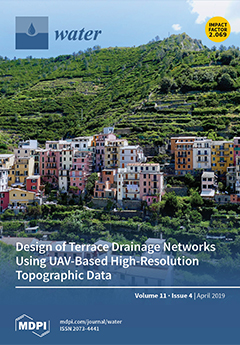An updated two-dimensional flow simulation program, FullSWOF-ZG, which fully (Full) solves shallow water (SW) equations for overland flow (OF) and includes submodules modeling infiltration by zones (Z) and flow interception by grate-inlet (G), was tested with 20 locally depressed curb inlets to validate the inlet efficiency (
Eci), and with 80 undepressed curb inlets to validate the inlet lengths (
LT) for 100% interception. Previous curb inlet equations were based on certain theoretical approximations and limited experimental data. In this study, 1000 road-curb inlet modeling cases from the combinations of 10 longitudinal slopes (
S0, 0.1–1%), 10 cross slopes (
Sx, 1.5–6%), and 10 upstream inflows (
Qin, 6–24 L/s) were established and modeled to determine
LT. The second 1000 modeling cases with the same 10
S0 and 10
Sx and 10 curb inlet lengths (
Lci, 0.15–1.5 m) were established to determine
Eci. The
LT and
Eci regression equations were developed as a function of input parameters (
S0,
Sx, and
Qin) and
Lci/
LT with the multiple linear regression method, respectively. Newly developed regression equations were applied to 10,000 inlet design cases (10
S0, 10
Sx, 10
Qin, and 10
Lci combinations) and comprehensively compared with three equations in previous studies. The 100% intercepted gutter flow (
Qg100) equations were derived, and over-prediction of
Qg100 from previous methods was strongly correlated to smaller
S0. Newly developed equations gave more accurate estimations of
LT and
Eci over a wide range of input parameters. These equations can be applied to designing urban drainage and road bioretention facilities, since they were developed using a large number of simulation runs with diverse input parameters, but previous methods often overpredict the gutter flow of total interception when the longitudinal slope
S0 is small.
Full article





